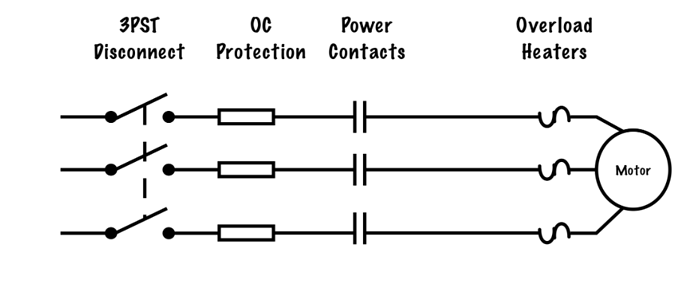The power circuit of a three-phase motor consists of the following items:
- 3PST three-phase disconnect
- Overcurrent protection
- Horsepower-rated motor starter contacts
- Overload relay heaters
In practical applications, these four components would often be mounted in a combination starter, which might house a circuit breaker and motor starter in the same cabinet.
In order for the motor to operate, the 3-phase disconnect must be closed, the fuses must be in good working order and the power contacts must be closed. The start and stop action of the motor is determined by the control circuit, which energizes the magnetic motor starter, pulling in or dropping out the armature that then opens or closes the power contacts.
The current that goes to the motor then runs through the heater elements of the overload relay. If the motor draws too high a current for too long, the heater element causes a normally closed contact to open, which then interrupts the current to the motor starters coil. This causes the power contacts to automatically open and turn off the motor.
This relationship also provides low-voltage protection (LVP) in the case of a power outage. Motors controlled from magnetic starters need to be manually reset following a period of low voltage.
The motor starters that we will be focusing on are “across-the-line” magnetic motor starters. This refers to them using full-line voltage to start the motor.
Across-the-line motor starters draw large inrush currents when energized. To minimize inrush currents and severe starting torques, some circuits use a variety of “soft-start” devices, but these devices are beyond the scope of this text.
Power circuits are identical for most 3-phase motor starters, so it is common not to refer to them in schematic drawings.
Reference
Basic Motor Control by Aaron Lee and Chad Flinn is used under a CC BY 4.0 Licence.
